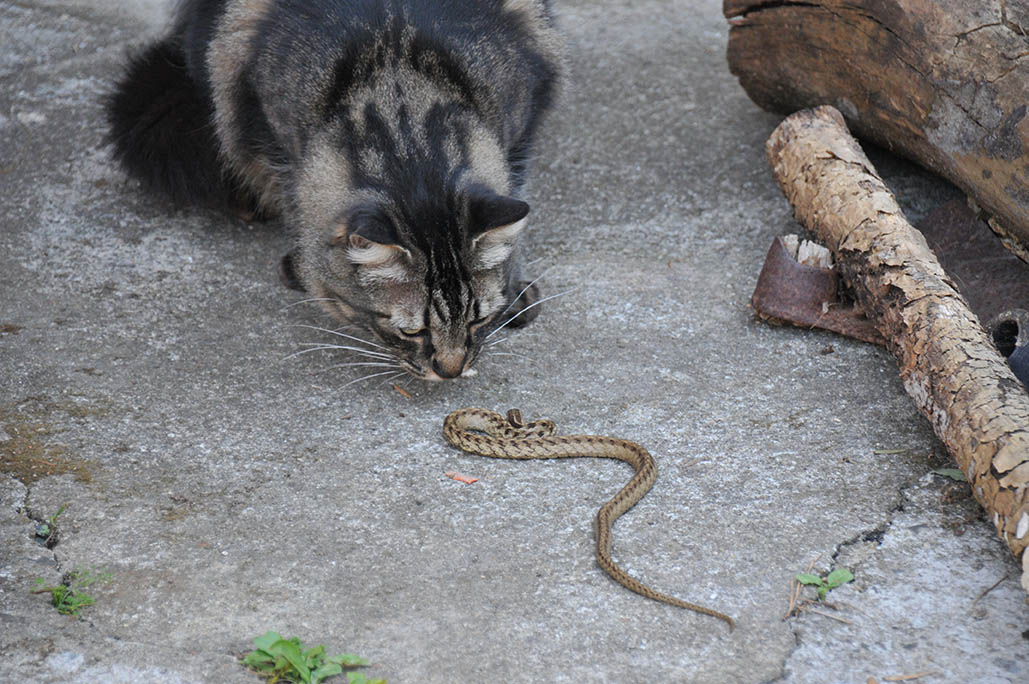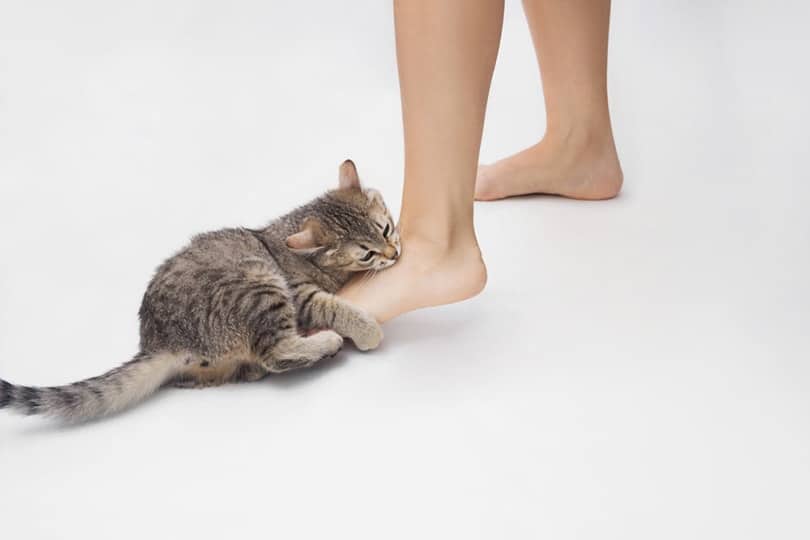Click to Skip Ahead
When the weather warms up, you’re likely to see a few snakes in your yard, especially if you live in rural areas with plenty of long grass and other foliage that snakes love to hide in. While they’re often feared and considered a nuisance, snakes help control rodent populations.
Natural predators like foxes, raccoons, and even cats can help keep snakes away. However, your snake-hunting feline is just as at risk of being bitten as you are if they encounter a snake. In this guide, we explore the reasons that cats can keep snakes away and a few ways to protect your cat from snake-caused injuries.

Are Snakes Afraid of Cats?
Snakes might not be “afraid” of cats in the same way that many of us are scared of snakes, but they likely have a wary respect for their fellow predators. Since cats are known to hunt snakes, the reptiles will often try their best to avoid encounters with these felines. More often than not, a snake will attempt to slither away unnoticed unless they’re forced to defend themselves.
If they can, most snakes that your cat encounters will choose the option of getting away without fighting. They are, after all, just as likely to get injured as your cat — if not more so — if they do decide to fight it out. However, if they can’t escape, some snakes will hiss and rear up to make themselves appear more threatening. If that doesn’t work, they’ll resort to feigned or actual strikes to ward off predators.
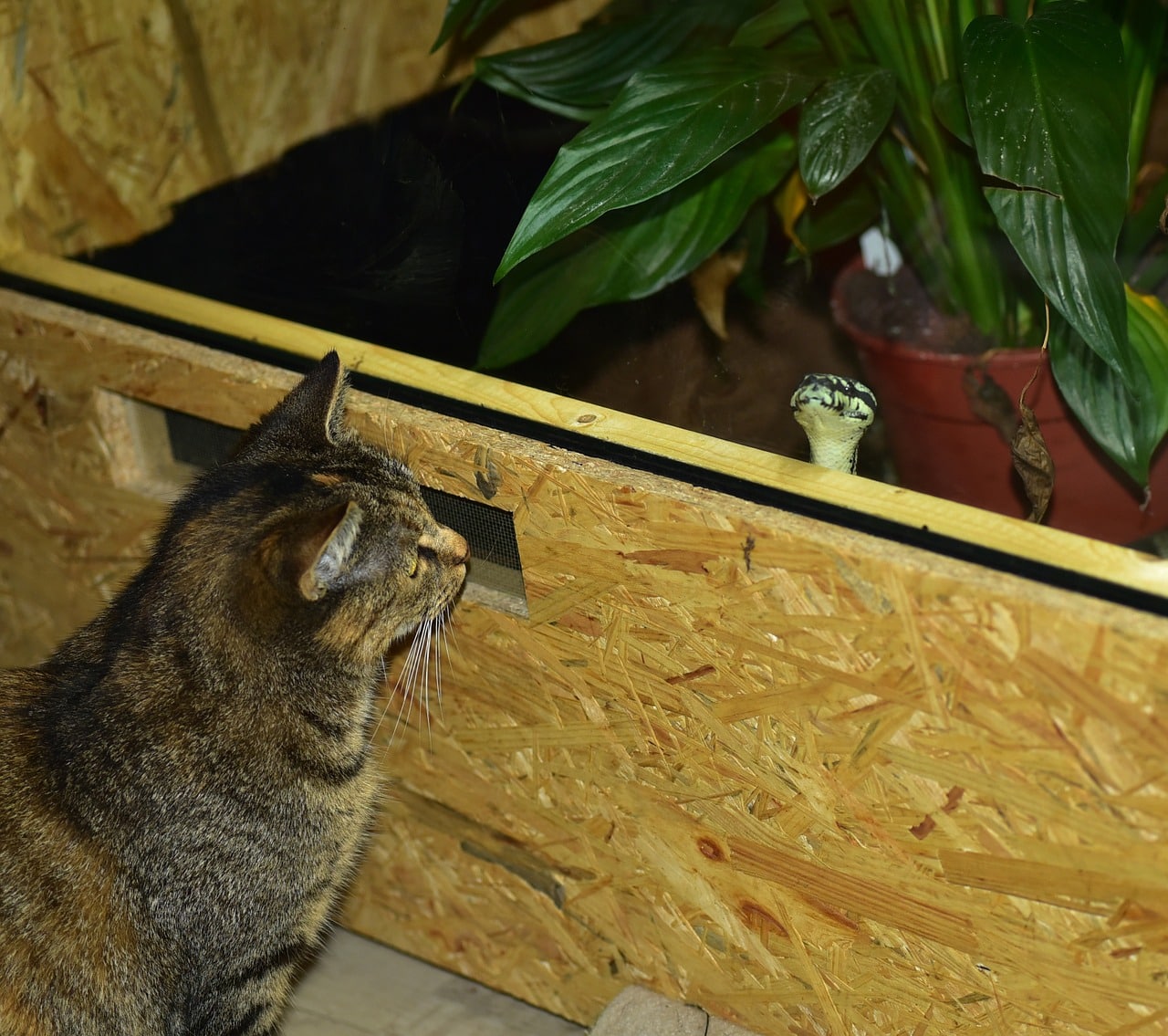
How Do Cats Keep Snakes Away?
As natural hunters, cats are drawn to the wriggling movement of a snake’s body. With the snake’s instinctive desire to stay undercover, they also pose an interesting hunt for your keen-eyed feline. While it might be strange to think that your lazy feline could be brave enough to take on snakes, hunting them isn’t the only way that cats keep snakes at bay.
The presence of cats also discourages snakes due to the fact they hunt the same prey: rodents. With a cat in the area, snakes will have competition for food. Along with the threat of being eaten themselves, snakes are likely to choose safer and less-challenging hunting grounds.

The 4 Dangers of Cats Encountering Snakes
Your cat might be able to keep snakes away from your home, but they can also get into trouble when facing down the slithering creatures.
1. Big Snakes
Not all the snakes that your cat encounters will be harmless garter snakes. If you live in an area with bigger snake species, like boa constrictors in South America, your cat could become prey instead. No matter how much of a street fighter your cat is, there are certain opponents that they can’t win against, and big snakes won’t be easy to hunt either.
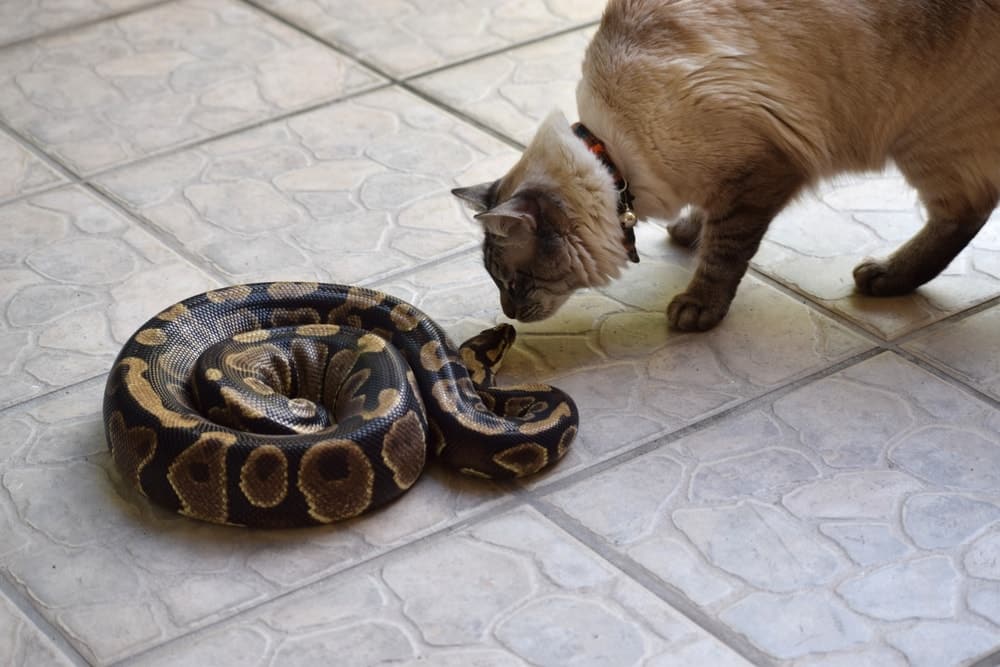
2. Lack of Skill
All felines are natural hunters, but not all cats have developed their skills enough to take on other predators, like snakes. If your cat is used to being indoors all the time, they’re less likely to have the skills required for street fighting.
It would be similar to someone who wrestles for a hobby taking on a professionally trained veteran in the field. While they might have the skills, they won’t have the same experience to match their opponent. If your cat isn’t familiar with snakes and how they move, they’re more likely to end up injured or on the losing side if they fight.
3. Snake Bites
Even if a snake isn’t venomous, their bite can still cause problems for your cat. When threatened, a snake will naturally react defensively. Biting back is their main line of offense.
Depending on how big the snake is, the injury that your cat sustains can range from minor to severe. The risk of snake bites doesn’t just end at the initial injury, however; there’s also the danger of infection as the bite heals.
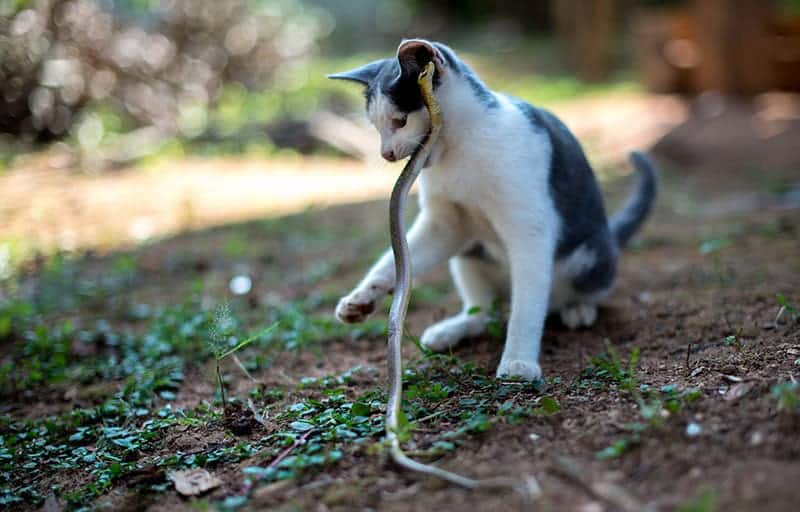
4. Venom
If you have snakes in your area, there are bound to be a couple that are venomous. Even if the snake isn’t considered deadly, their venom can still make your cat sick or be fatal if your cat gets bitten. In the U.S.A., you can find four venomous snake species. Coral snakes, water moccasins or cottonmouths, copperheads, and rattlesnakes can be found throughout the U.S.A., and all pose a threat to cats and humans.
Venom is the biggest reason that you should take your cat to a veterinarian if you believe that they’ve been bitten by a snake. Even if you’re not sure they encountered a venomous species, the earlier you get them treated, the greater chance your cat has of surviving the encounter.
Some of the signs of a venomous snake bite include:
- Difficulty breathing
- Dilated pupils
- Discolored tissue
- Incontinence
- Muscle twitching
- Paralysis
- Swelling
- Vomiting
- Weakness
If your pet is showing these signs, we suggest you speak to a vet.
If you need to speak with a vet but can't get to one, head over to PangoVet. It's an online service where you can talk to a vet online and get the advice you need for your pet — all at an affordable price!

How to Keep Snakes Away Without Involving a Cat
If you don’t have a cat or prefer to keep your cat safe indoors, there are several other ways that you can prevent snakes from staying around your home.
1. Cut the Grass
Despite their fierce reputation, snakes are relatively shy creatures. Unless they’re sunning themselves on a warm rock, snakes prefer dark, well-covered areas, which is why they nest in cracks or holes. The longer the grass in your yard is, the more coverage it offers for snakes to slither through. Keep it short to discourage snakes from getting too close to your home.
2. Keep Rodents Away
Not only are rodents considered pests to the home and chicken coop, but they can also attract snakes. The more mice you have hiding out in your backyard, the more likely you are to have a few snakes taking advantage of the free hunting ground.
By making your home less friendly to rodents, you’ll also minimize the number of snakes attracted to the area. Use mouse or rat traps, and keep animal feed secured in rodent-proof containers. You can also use electronic deterrents or strong-smelling plants, like peppermint.
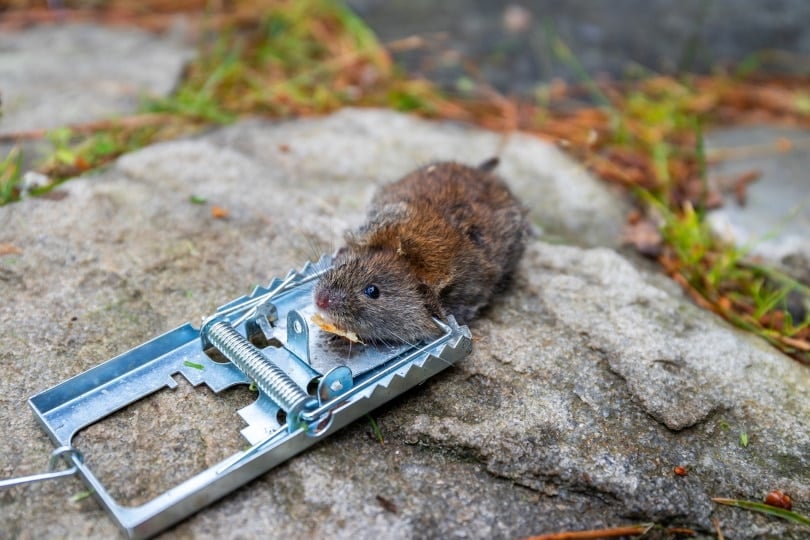
3. Take Advantage of Natural Predators
Cats aren’t the only animals that are great at keeping snakes away; several other animals are natural snake deterrents too. Raccoons and foxes are the most common predators for snakes, Birds of prey like hawks and eagles, will also hunt for snakes. Support conservation efforts to keep natural species in a healthy ecosystem.
4. Remove Entry Points
One of the biggest problems with snakes is their ability to find their way into your home and build a nest somewhere. They do this by finding an entry point, such as a damaged fly screen on a window, broken ventilation duct, or overhanging tree branch.
Pay close attention to any potential entrances to your home that snakes can use, and seal them. Not only will keeping your house maintained prevent snakes from invading, but you’ll also be less likely to invite in rodents.
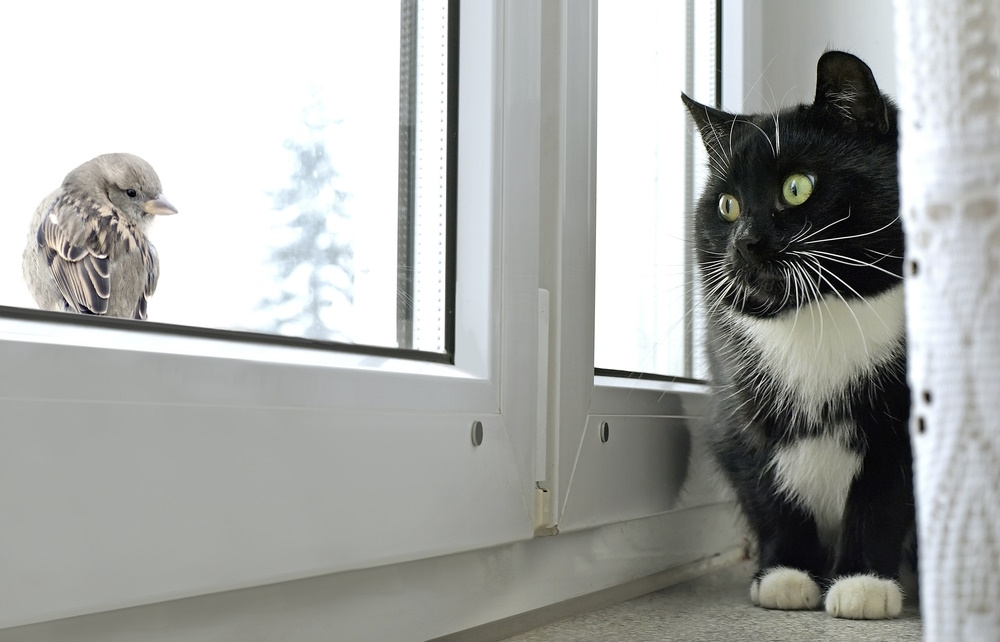

Conclusion
Cats can help keep snakes away from your home by hunting the snakes themselves and by hunting rodents in the area. Snakes are discouraged from wanting to stay nearby due to the threat to their survival and the competition for food. However, cats can be injured when they encounter snakes and get bitten, especially if the snake is venomous.
You can help keep snakes away from your home, and your cat safe, by making your yard unattractive to snakes and rodents.
- See Also: Can A Cat Sense Snakes?
Featured Image Credit: Pedro Hamilton Oliveira, Shutterstock

